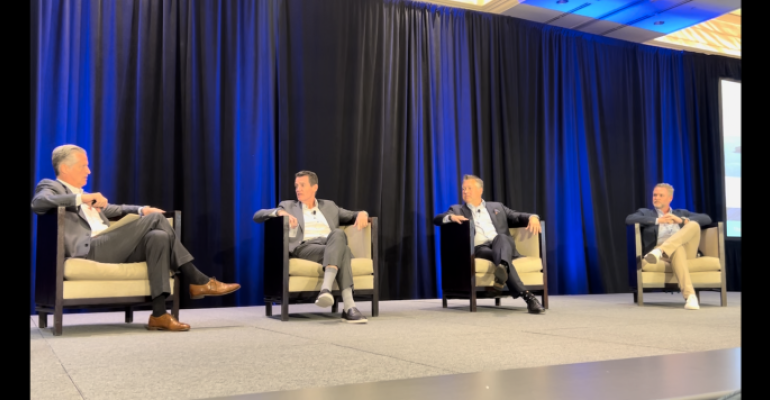Prior to 2008, it was somewhat rare for an advisor to depart a wirehouse and strike out on their own. In 2022, however, the wirehouse channel lost more than 600 advisors and $320 billion in client assets to other wealth management models in a growing trend.
At the same time, independent RIAs added the most advisors in 2022—nearly 850, while hybrid RIAs added the most assets, at more than $140 billion.
The only other channel to lose both assets and talent last year was bank-based broker/dealers.
Two things happened at the end of the aughts that changed the way advisors viewed independence, said Old Greenwich Consultants CEO Jeff Bischoff and NewEdge Capital Group Co-Managing Partner Alex Goss, speaking at Echelon Partners’ Deals and Dealmakers Summit this week in Laguna Niguel, Calif. For one, wirehouses began buying up regional broker/dealers like Smith Barney and A.G. Edwards, Goss said.
“There was a ton of advisor choice,” he said. “These were firms that advisors loved and were happy to be with. And then, ’08 happened, massive consolidation. Pretty much predominantly bank-owned environment for the wirehouse, complete universal dissatisfaction with advisors at the wirehouses, everybody’s miserable.”
It was around the same time, noted Bischoff, that partnership platforms like Hightower Advisors and Dynasty Financial Partners came into existence and provided an easier offramp for small advisors without the means to do it alone.
Going independent requires total commitment and a new way of thinking, said Fusion Financial Partners CEO Mike Papedis, a strategic consultant to breakaway advisors, beginning with a new vocabulary.
“Words like production, GDC, trailing 12—those don’t translate over into the independent RIA space,” he said. “They have to start using new terminology. A dollar of revenue from an RIA equals a dollar of revenue, not a payout, not a pay cut or any of those different translations. Also you have to start understanding what expenses, what SG&A means, miscellaneous expenses, and then really focusing on the earnings of that practice.
“The faster that the wirehouse team can make that conversion, it will help them in any conversations they may have about joining new firms, looking at their own forecasts for launching an RIA and then ultimately understanding what that enterprise value that they're creating really becomes.”
The next first step, he said, is to organize production reports in a way that can be read by potential partners, investors or consultants and create a proforma P&L. It’s also important that a transitioning team understands how the value of their practice will change when it becomes a business and how they will need to work together in new ways to make that business successful.
Jim Gold, CEO of Steward Partners, a $30 billion hybrid RIA that recruits nearly all its advisors from wirehouses, said he expects to see three years’ worth of data from potential recruits.
“We want to make sure there are no anomalies. You want to see, is the business growing? Is it shrinking?” he said. “So, we spend a lot of time digging into that data.”
Goss said his firm tends to approach deals qualitatively at first, determining whether the individual or team would be a good cultural fit.
“A small deal and a big deal take about the same amount of time and effort and resources to get closed, so we also try to get a feel about the complexity of the team,” he said. A firm with low EBITDA and seven advisors who are all decisionmakers would be unlikely to make the cut, as an example.
“Usually, it's a little art versus science, I think, but it always starts qualitatively,” he added. “I think that helps us be better at spending our time on deals that we want to close, and I think it also helps our close rate increase as well.”
When it comes to what firms are looking for, each one is different. Wealth Enhancement Group, for instance, isn’t interested in advisors straight out of the wirehouses. On a different panel this week, WEG CEO Jeff Dekko said he prefers to acquire firms after they’ve already gone independent.
Some recruiters will shell out based on geography, age range, amount of assets or niche specialties. Others may prefer advisors with specific investment or planning styles, from a specific type of firm or with a specific sort of clientele. Virtually all acquisitive firms, however, are looking for growth potential and cultural alignment.
Many active acquirers, including Steward and NewEdge, offer incoming advisors the option to affiliate as 1099 or W-2 employees, and Goss said he's seen “a major mind-blowing move of advisors you would have thought would have wanted to be independent forever” move to the W-2 model.
“I think it's an awesome time to be a financial advisor because you have more choices than you've had in a long, long time, and I think a lot of the groups here are really leading charge and providing that choice,” he said.
Gold said “inertia” and fear of losing clients are the biggest obstacles for wirehouse advisors to make the jump to independence, but he said that’s changing as they see other advisors leaving and taking their books of business with them.
“It’s no longer the trailblazers or innovators making the leap from wirehouse to the independence,” agreed Papedis. “It’s like that old saying, ‘success feeds success.’ They have peers and colleagues and friends that have done it and saw that success, so then they're ready to take the same jump.”
Gold cited data from Cerulli Associates from 2005 and 2006, which show that the wirehouses had over half of all industry revenue.
“Every one of them today will tell you, which is true, that they have record assets per advisor and record productivity, but their market share is now 37%,” he said. “And the forecast is going to go probably down to like 20%, 25%—and the vast majority of that's coming up this side of the world.”







